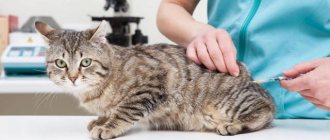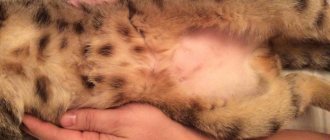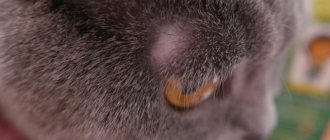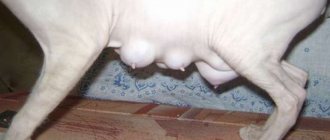Alopecia, or feline hair loss: what is it?
All cats shed twice a year, and this is the norm. How to distinguish: is it molting (the process when the fur is renewed) or pathology (baldness of the animal)? To do this, you need to know how the disease manifests itself, what its prerequisites are and in what cases the owner needs to sound the alarm.
Alopecia is the name given to abnormal hair loss in cats, as a result of which bald spots are formed on the animal's body - areas with absolutely no hair. The fur may fall out in clumps, forming bald areas on the animal's head, ears, and paws. Having noticed such areas, the owner should immediately take the pet to an appointment with a veterinarian. Baldness can be a signal of serious problems in the animal’s body.
But this should not be confused with hair loss, which normally occurs in all healthy felines. Cats lose their fur during:
- molting (a seasonal change of “coat” occurs twice a year; cats usually shed more than males);
- stress (the animal may shed some hair due to excitement);
- age-related changes (old animals lose hair and whiskers);
- frequent bathing (this is why it is recommended to bathe the animal only if necessary; twice a year is quite enough).
At the same time, the wool does not come out in clumps, without forming bald spots. But the disease has slightly different symptoms.
Diagnostics
It can be difficult to determine the cause of a cat's bald spot based on an in-person examination. To do this, the veterinarian can conduct a number of laboratory tests. An allergen can be identified by monitoring the body's reaction to various substances or using special tests and blood tests.
The presence of lichen is confirmed by microscopic and luminescent analyzes of skin scrapings.
The diagnosis of weeping dermatitis is made when at least 3 characteristic symptoms are present. They also take an analysis for pathogenic microflora.
Ectoparasites are easy to detect during regular examination of the animal. Pyoderma is diagnosed by bacteriological culture; in rare cases, a biopsy may be used.
Pemphigus can be detected using cytological analysis and biopsy. To diagnose diseases of internal organs, blood, stool and urine tests, ultrasound or x-rays may be required.
Alopecia symptoms
You can recognize alopecia in a pet by the following signs:
- The fur falls out excessively, in clumps. Bald spots in cats appear mainly behind the ear, in the neck, back, and on the tail.
- The skin in these places may have its usual pink color or turn red, sores or scabs may appear there.
- Check your pet's reaction to touching the bald spot: perhaps the spot hurts or itches.
- Check if the animal has symmetrical bald spots.
If you notice these symptoms, you should urgently seek professional help from a veterinarian. Otherwise the disease will progress.
Endoparasites
If you notice your pet constantly wanting to scratch a bare area, this may indicate the presence of endoparasites. For example, scratching with teeth or claws may occur in an animal due to unpleasant flea bites. In order to relieve the animal from unpleasant sensations, special solutions, sprays and drops for the withers are used. Treatment must be carried out several times in order to remove not only adult individuals from the fur, but also newly hatched larvae.
Of all the internal organs, the intestines are the most susceptible to parasite penetration. Antihelmintic drugs are excellent for removing worms from the body. However, if the case is advanced (for example, when infected with large worms), the cat may need surgical intervention.
You might be interested in: The cat’s hind legs have failed: what is the reason, what to do?
Ear mites can be treated with drops and proper care for your pet. You will need to remove him from contact with stray animals and prohibit him from eating rodents and wild birds.
Causes of this disease
If an animal has bald spots on its body and head, this may be a sign of a food allergy. Allergies should be looked for in your pet's diet. They can be:
- Proteins of animal and plant origin;
- Various cereals;
- Meat – in particular lamb.
In addition, it may be an allergic reaction to flea bites, cigarette smoke or other odors (inhalation allergy).
The causes of baldness may lie in the psychological state of the pet, that is, hair may fall out due to stress. If the veterinarian diagnoses this reason, then the first thing the owner needs to do is find out what kind of stress or experience the pet has had recently, eliminate it, and only after that give sedatives, which only in this case will be effective. Symptoms of alopecia of a psychogenic nature are bald patches that are located on the thighs, abdomen or paws.
The causes belonging to the third group are infectious. If a cat's hair is falling out, the culprit may be scabies, lichen, fungus, or mites. If a cat has a bald spot behind its ear, it could be ringworm. There are several varieties: fungal (another name is ringworm; contagious to humans), psoriasis or eczema, viral.
Hair mites can also cause hair loss. They are very small and impossible to notice with the naked eye. Lice eaters do not live long, but they reproduce very quickly.
If your cat has bald spots on its neck, the cause may be dermatitis. It can be caused by various chemical and biological factors. Even treatment for parasites can cause hair loss.
Hair loss can be a consequence of seborrhea, a disease in which the functioning of the sebaceous glands is disrupted. This is usually indicated by baldness in a cat near the tail. That is why this disease is sometimes called “greasy tail”.
Another group of problems that cause baldness is disruption of the hormonal system:
- thyroid problems, manifested by both increased and insufficient levels of hormone production;
- diabetes;
- malfunctions of the adrenal glands, in particular their hyperfunction.
Other reasons include the presence of tumors in the animal, genetic predisposition and reactions to medications. Thus, a kitten’s bald spot may appear due to the fact that during pregnancy its mother did not receive various essential minerals and vitamins.
Non-communicable diseases
The following unfavorable factors of non-contagious etiology lead to the formation of alopecia:
- Unbalanced feeding: in economy class feeds, as well as feed mixtures from natural products, there is not enough building material and biological catalysts for the formation of hairs and maintaining skin health. Therefore, veterinarians recommend using ready-made food of at least premium class. To prepare a feed mixture from natural products, the cat owner needs to acquire the skills of preparing diets. Uncontrolled use of vitamin supplements leads to poisoning and hair loss.
- Allergic reactions: there are allergies to food components, external irritants - pollen, odors, accessories, household items. The fight against the disease consists of eliminating harmful factors. The veterinarian prescribes antihistamines, as well as professional hypoallergenic food.
- Stress: fright, moving, participation in an exhibition, the appearance of a new pet in the apartment. Leads to the loss of a significant part of the coat. Treatment and prevention consists of preventing stressful situations, as well as taking Stop-stress or Vetspokoin medications.
Be sure to read:
What can cause a cat's cheek to swell: causes of swelling and puffiness on the face under the eye
Result of stress
- Hormonal imbalance: congenital or acquired abnormalities are associated primarily with hypothyroidism - insufficient secretion of thyroid hormones. In addition to symmetrical bilateral baldness, cold intolerance, obesity, and hair discoloration occur. The muzzle takes on a pained expression. Treatment consists of lifelong injections of thyroid hormones.
- Congenital pathologies - hypotrichosis and seborrhea. In the first case, babies are born with sparse hair, and by four months they lose the rest of their hair. Pets are constantly cold. No treatment has been developed. Seborrhea is an abnormality of the sebaceous glands. Inflammation develops, in which the hair follicles die along with the sebaceous glands. The most commonly known symptom is the greasy tail. Treatment is symptomatic.
Greasy tail
- Chemical and physical reasons: hair falls out due to unqualified treatment with anti-flea drugs, as well as exposure to overheating when the pet’s rookery is located near functioning heating radiators.
There are situations when a cat sheds all its hair at once for no apparent reason. Possibly, toxic substances enter and accumulate with food, water, and inhaled air.
The body tries to remove toxins from the body in every possible way. First, it directs them to the least valuable parts of the body - hair. When the concentration of toxins reaches a threshold level, hair rejection occurs.
Diagnosis of the disease
If a cat's hair falls out in clumps before bald spots form, it should definitely be seen by a specialist. Only a veterinarian can accurately determine the diagnosis. To determine the disease and prescribe the correct treatment, the doctor must:
- Find out how and when the disease manifested itself. The owner will have to tell in great detail the animal’s lifestyle, what the pet ate and drank, what it came into contact with, and whether it walked outside.
- Examine the patient.
- Examine hair roots under a microscope.
- You may need blood and hormone test data, and a scraping will be required.
- Sometimes an ultrasound or x-ray is done to confirm or rule out the presence of tumors.
Prevention
Instead of treating your cat's bald spots, you can prevent them from occurring. This is very easy to do, you just need to follow some rules:
- Compliance with animal hygiene is mandatory. To do this, carefully examine the skin and fur. This should be done especially scrupulously by those owners whose pet often walks outside. If you find parasites (ticks, fleas, etc.), get rid of them as soon as possible.
- Maintaining a feeding regime and a balanced diet. The food must contain all the necessary microelements and nutrients. Harmfulness is excluded.
- Arrangement of all routine vaccinations.
- Regular visits to the veterinary clinic. Visit your veterinarian at least twice a year for examination and laboratory tests if necessary.
Treatment of hair loss in cats
Hair loss in cats is a serious but completely treatable disease. Treatment must be selected individually. What medications the doctor will prescribe depends on the causes of the disease. If bald spots on the ears or other places appear due to allergies, the animal must first be isolated from the allergen. The doctor also prescribes drugs that stimulate the immune system and antiallergic medications. If there is a food allergy, you should review the animal’s diet and switch it to hypoallergenic foods.
If the cause of an animal's hair loss is parasites, the pet is treated with gel and ointment that have antiparasitic properties. In such cases, it is also recommended to give the pet drugs that stimulate the immune system.
If the bald spots were caused by an abscess, the animal must undergo a course of treatment with antibiotics and antiseptics. If a cat has been diagnosed with endocrine problems, she is prescribed hormonal medications.
Preventive measures
To prevent ear baldness in cats and hair loss on other parts of the body, it is recommended to take preventive measures in advance. Namely:
- regularly independently examine the animal, take it for professional examinations, and, if necessary, for treatment at the veterinarian;
- vaccinate your pet on time;
- do not forget about proper hygienic care of the cat;
- Provide your pet with proper nutrition.
Bald spots in cats on the head, ears, belly or paws are a fairly common phenomenon. Why a cat has bald spots on its back or other parts of its body - only a doctor can say for sure after conducting the appropriate diagnosis. Depending on this, treatment is prescribed, which can consist only of diet, or contain a course of hormonal drugs or antibiotics. But it is highly not recommended to self-medicate your pet: you can only torture the animal with unnecessary drugs, and in the meantime the cat will lose most of its fur coat.
Bald spots at first glance seem harmless, although they spoil the aesthetic appearance of the animal. But it should be understood that they can be provoked by quite serious diseases that develop in a pet. Therefore, you should not hesitate to visit the doctor.
Diagnosis and treatment
Before prescribing treatment procedures, the veterinarian will conduct diagnostics to identify the cause of the disease. To do this, a medical history is collected - information from the owner about the pet’s lifestyle, previous diseases, and nutrition. After the interview, the doctor proceeds to an external examination of the animal. He checks the color of the bald spot, the degree of damage, and size. Then he takes the hairs and scrapings for examination under a microscope. Laboratory tests include blood tests. If oncology is suspected - ultrasound, radiography.
Treatment depends on the cause of baldness:
- In case of allergies, the irritant is eliminated, antihistamines are prescribed (Cetirizine, Fenistil, Diazolin, Bicarfen, Tavegil).
- Depending on the type of infection - antibiotics, anti-inflammatory, antifungal agents. Medicines are selected for internal or external use (ointments, sprays, drops).
- If parasites are detected - anti-parasitic pet shampoos, drops on the withers, sprays.
- Disturbances in the functioning of the endocrine system - hormonal drugs.
Bald areas are treated with antiseptic agents. To restore the body's defenses - immunostimulants, vitamin and mineral supplements. Alopecia in cats is a common disease, but with timely treatment it can be eliminated. The main thing is to seek help from a veterinarian. Self-treatment can lead to complications and deterioration of your pet’s health.
Causes of cat baldness
If an animal constantly loses hair in excessive amounts, you need to find out why this is happening. Alopecia in cats can be caused by both physiological and pathological reasons. If the former do not require special measures, then the latter cannot be ignored, because they can lead to dangerous complications, including death.
Adenitis of the sebaceous glands
This disease is detected in kittens and older cats and is accompanied by inflammation and disruption of the functioning of the sebaceous glands, as a result of which the animal’s hair breaks or hair falls out. Balding usually occurs on the head, ears and neck. Scales and dry crusts also form. Bald spots have a round shape. Often a foul odor emanates from your pet.
If the disease is advanced, bald patches appear on the back and at the base of the tail. At the same time, the skin itches unbearably, and the cat constantly scratches it. The scales turn yellow or gray and become moist and sticky.
Hereditary hypotrichosis
This is not a disease, but an incurable genetic abnormality. Typically, kittens with this defect are born completely hairless or lose all of their fur during the first month of life. Over time, bald skin becomes rougher and does not react so sharply to negative external factors. However, sensitivity to temperature changes remains.
Alopecia due to hypotrichosis is not always generalized. It can also be regional. Bald areas are usually hyperpigmented and affected by seborrhea. The anomaly does not affect the quality of life of its owner. The pet simply needs to be protected from hypothermia and excluded from breeding.
Reaction to stress
These vulnerable creatures are sensitive to any changes, be it a change of place of residence, a trip in a car, a negative family environment, harsh treatment, fear, or a visit to the veterinarian. These factors can cause disturbances in the cat’s emotional background, which is reflected in its appearance, in particular the condition of its fur. In cats experiencing severe stress, it often comes out in clumps. In some cases, this can lead to the formation of extensive bald patches.
Sometimes stress leads to the development of mental illnesses, in which the cat may begin to chew or tear out its fur in shreds. Bald spots, sores and bruises form in these places. Severe emotional shock also affects the behavior of the animal. It becomes apathetic, loses interest in food, and suffers from bowel dysfunction.
What can sores on a cat's back mean?
Have you been trying to heal your JOINTS for many years?
Head of the Institute for the Treatment of Joints: “You will be amazed at how easy it is to cure your joints by taking the product every day for 147 rubles .
There are several causes of back pain in cats. The most common :
Our readers successfully use Sustalaif to treat joints. Seeing how popular this product is, we decided to bring it to your attention. Read more here...
- Fleas, when biting a pet, leave wounds that, although tiny, can be very itchy. The animal scratches the affected areas, which aggravates the situation. The risk of infection cannot be excluded, which leads to the formation of sores. Fleas are the most common cause of such troubles.
- Allergies can also cause sores in cats. It can be triggered by food, household chemicals and hygiene products, dust, smoke, etc. In addition to skin lesions that itch, other symptoms may be present - watery eyes, nervousness, digestive disorders, coughing, sneezing, nasal discharge. Quite often, taurine, which is part of some cat foods, provokes an allergic reaction.
- Ringworm. The sores with it have a characteristic appearance. This is not a rash, not nodules, but spots with bare pink skin, which over time become covered with brown dry crusts. They fall off over time when the animal scratches the sore. As a result, the wound becomes wet, often bleeding, and is very annoying for the pet. Ringworm tends to spread quickly and take over larger and larger areas of the unfortunate animal's body. Its other name is dermatophytosis (dermatophytes are fungi that cause the disease).
- Demodicosis is diagnosed if sores appear on the cat’s back along the ridge. The development of this pathology is provoked by mites, which, when they get under the pet’s skin, begin to destroy the dermis with their vital activity, and as a result, serious lesions appear. The disease is considered dangerous. May lead to death of the animal. It cannot be treated in advanced stages.










